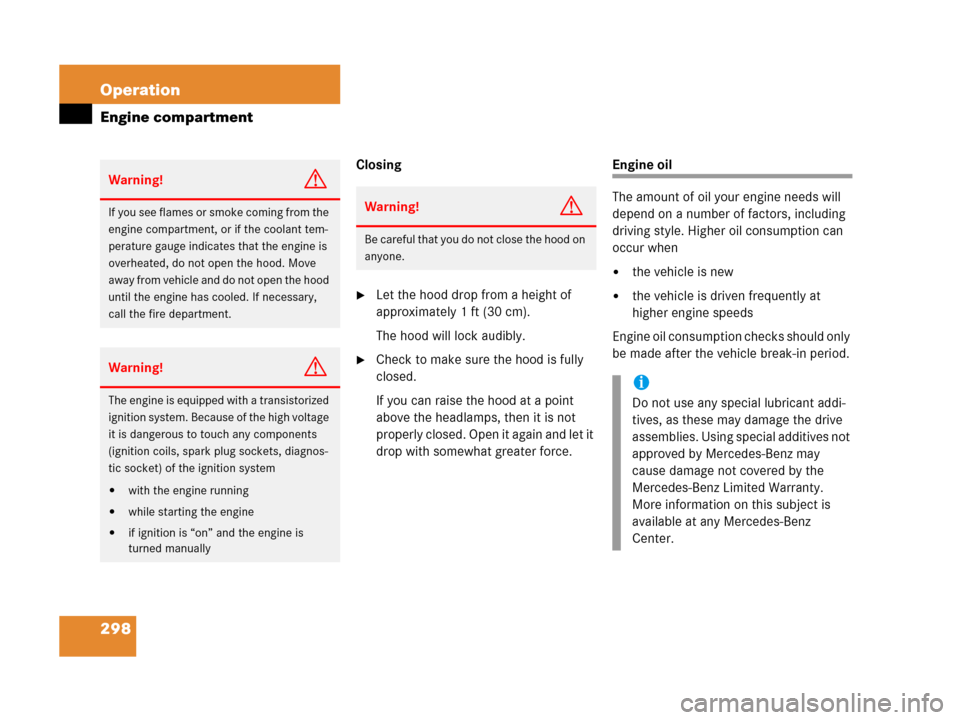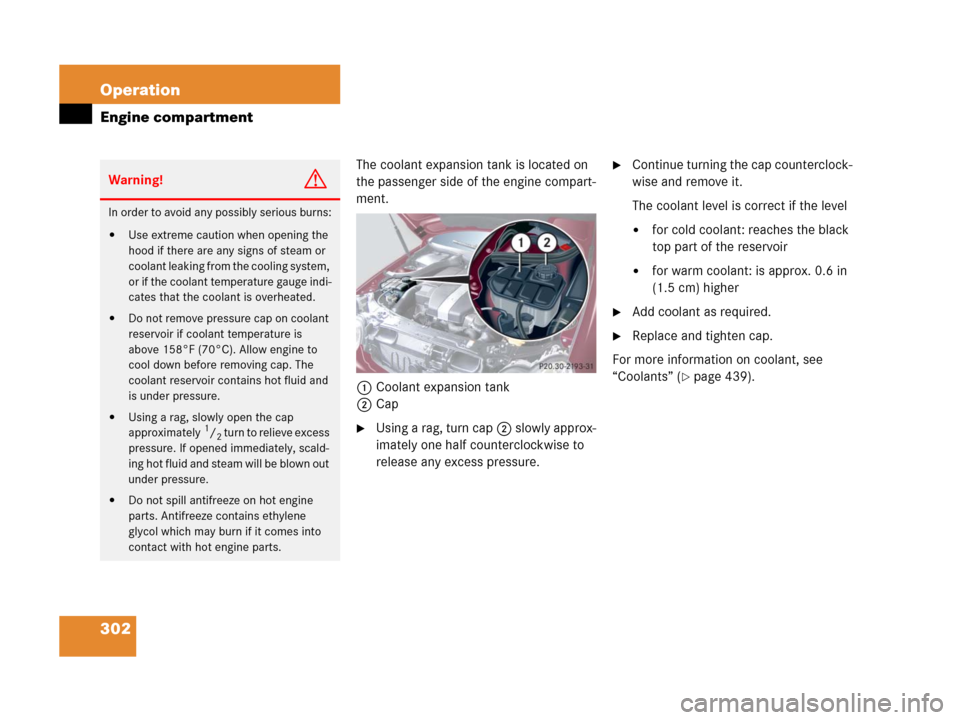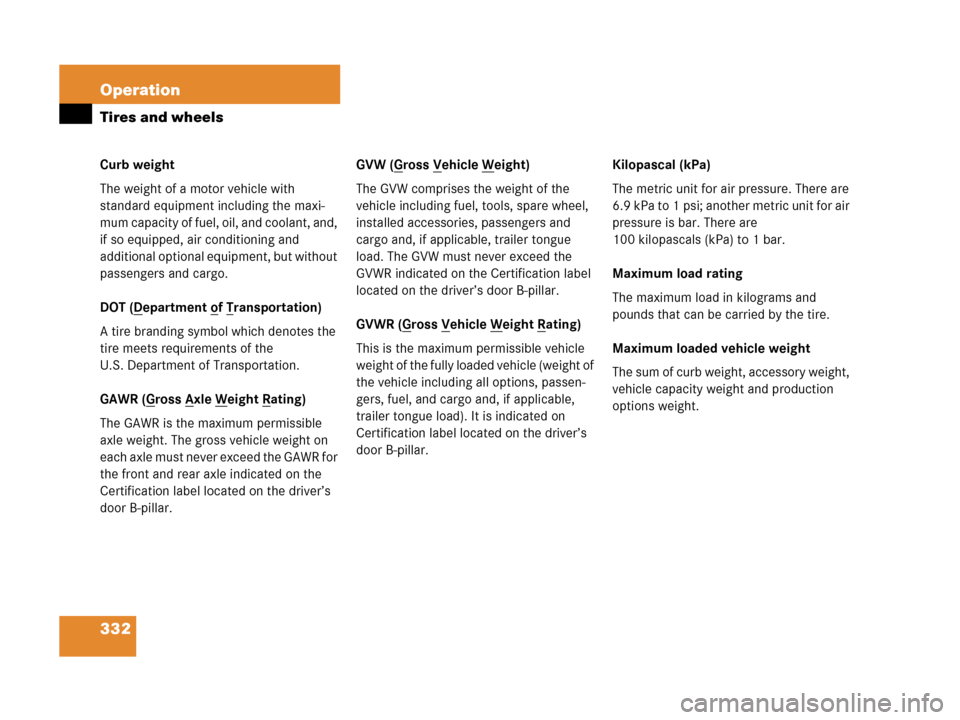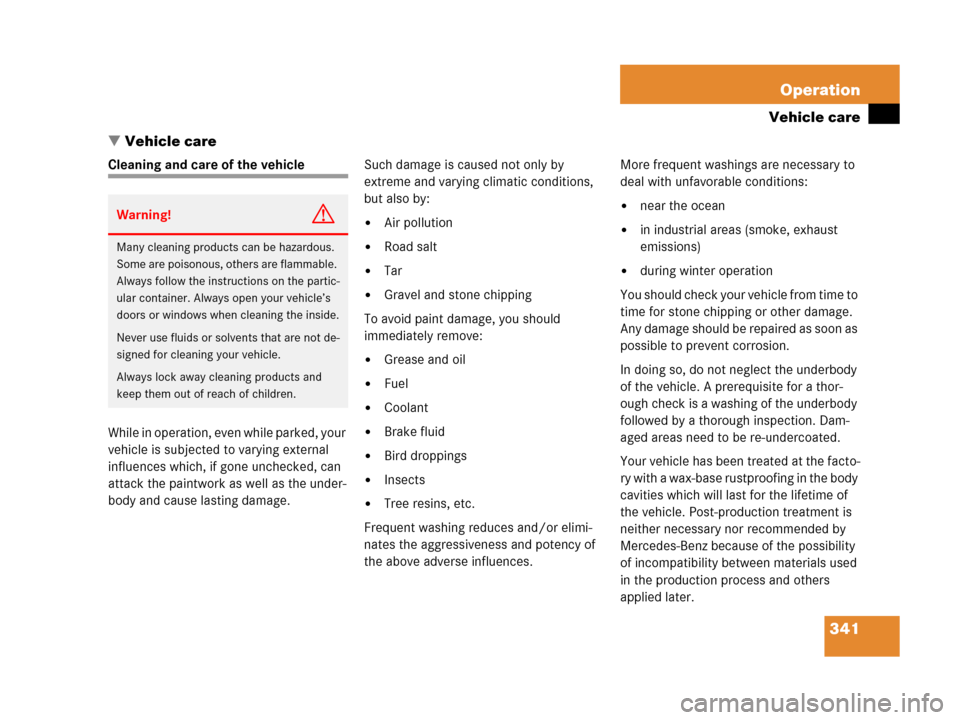Page 295 of 473
294 Operation
At the gas station
�Replace fuel cap by turning it clockwise
until it audibly engages.
�Close fuel filler flap.
Check regularly and before a long trip
1Coolant
2Brake fluid (fuse box cover removed)
3Windshield washer and headlamp
cleaning system*
Warning!G
Overfilling of the fuel tank may create
pressure in the system which could cause a
gas discharge. This could cause the gas to
spray back out when removing the fuel
pump nozzle, which could cause personal
injury.
i
Leaving the engine running and the fuel
cap open can cause the yellow fuel
tank reserve warning lamp to flash and
theú malfunction indicator lamp
(USA only) or the± malfunction in-
dicator lamp (Canada only) to illumi-
nate.
For more information, see “Practical
hints” (
�page 352) and (�page 353).
i
Opening the hood, see (�page 297).
��
Page 296 of 473

295 Operation
At the gas station
Coolant
For normal replenishing, use water (pota-
ble water quality). For more information,
see “Coolant level” (
�page 301) and
“Fuels, coolants, lubricants, etc.”
(
�page 436).
Brake fluid
Removing fuse box cover (
�page 421).Windshield washer and headlamp
cleaning system*
For more information on filling up the
washer reservoir, see “Windshield washer
system and headlamp cleaning system*”
(
�page 304).
Engine oil level
For more information on engine oil level,
see “Engine oil” (
�page 298).Vehicle lighting
Check function and cleanliness. For more
information on replacing light bulbs, see
“Replacing bulbs” (
�page 394).
Exterior lamp switch (
�page 114).
!
If you find that the brake fluid in the
brake fluid reservoir has fallen to the
minimum mark or below, have the
brake system checked for brake pad
thickness and leaks immediately.
Notify an authorized Mercedes-Benz
Center immediately. Do not add brake
fluid as this will not solve the problem.
For more information, see “Practical
hints” (
�page 351).
Page 299 of 473

298 Operation
Engine compartment
Closing
�Let the hood drop from a height of
approximately 1 ft (30 cm).
The hood will lock audibly.
�Check to make sure the hood is fully
closed.
If you can raise the hood at a point
above the headlamps, then it is not
properly closed. Open it again and let it
drop with somewhat greater force.
Engine oil
The amount of oil your engine needs will
depend on a number of factors, including
driving style. Higher oil consumption can
occur when
�the vehicle is new
�the vehicle is driven frequently at
higher engine speeds
Engine oil consumption checks should only
be made after the vehicle break-in period.
Warning!G
If you see flames or smoke coming from the
engine compartment, or if the coolant tem-
perature gauge indicates that the engine is
overheated, do not open the hood. Move
away from vehicle and do not open the hood
until the engine has cooled. If necessary,
call the fire department.
Warning!G
The engine is equipped with a transistorized
ignition system. Because of the high voltage
it is dangerous to touch any components
(ignition coils, spark plug sockets, diagnos-
tic socket) of the ignition system
�with the engine running
�while starting the engine
�if ignition is “on” and the engine is
turned manually
Warning!G
Be careful that you do not close the hood on
anyone.
i
Do not use any special lubricant addi-
tives, as these may damage the drive
assemblies. Using special additives not
approved by Mercedes-Benz may
cause damage not covered by the
Mercedes-Benz Limited Warranty.
More information on this subject is
available at any Mercedes-Benz
Center.
Page 302 of 473
301 Operation
Engine compartment
1Filler cap
�Unscrew filler cap1 from filler neck.
�Add engine oil as required. Be careful
not to overfill with oil.
Be careful not to spill any oil when adding.
Avoid environmental damage caused by oil
entering the ground or water.
�Screw filler cap1 back on filler neck.
For more information on engine oil, see the
“Technical data” section (
�page 436) and
(
�page 437).
Transmission fluid level
The transmission fluid level does not need
to be checked. If you notice transmission
fluid loss or gear shifting malfunctions,
have an authorized Mercedes-Benz Center
check the transmission.
Coolant level
The engine coolant is a mixture of water
and anticorrosion/antifreeze. To check
the coolant level, the vehicle must be
parked on level ground and the engine
must be cool.
!
Excess oil must be siphoned or drained
off. It could cause damage to the
engine and catalytic converter not
covered by the Mercedes-Benz Limited
Warranty.
Page 303 of 473

302 Operation
Engine compartment
The coolant expansion tank is located on
the passenger side of the engine compart-
ment.
1Coolant expansion tank
2Cap
�Using a rag, turn cap2 slowly approx-
imately one half counterclockwise to
release any excess pressure.
�Continue turning the cap counterclock-
wise and remove it.
The coolant level is correct if the level
�for cold coolant: reaches the black
top part of the reservoir
�for warm coolant: is approx. 0.6 in
(1.5 cm) higher
�Add coolant as required.
�Replace and tighten cap.
For more information on coolant, see
“Coolants” (
�page 439).
Warning!G
In order to avoid any possibly serious burns:
�Use extreme caution when opening the
hood if there are any signs of steam or
coolant leaking from the cooling system,
or if the coolant temperature gauge indi-
cates that the coolant is overheated.
�Do not remove pressure cap on coolant
reservoir if coolant temperature is
above 158°F (70°C). Allow engine to
cool down before removing cap. The
coolant reservoir contains hot fluid and
is under pressure.
�Using a rag, slowly open the cap
approximately1/2 turn to relieve excess
pressure. If opened immediately, scald-
ing hot fluid and steam will be blown out
under pressure.
�Do not spill antifreeze on hot engine
parts. Antifreeze contains ethylene
glycol which may burn if it comes into
contact with hot engine parts.
Page 333 of 473

332 Operation
Tires and wheels
Curb weight
The weight of a motor vehicle with
standard equipment including the maxi-
mum capacity of fuel, oil, and coolant, and,
if so equipped, air conditioning and
additional optional equipment, but without
passengers and cargo.
DOT (D
epartment of Transportation)
A tire branding symbol which denotes the
tire meets requirements of the
U.S. Department of Transportation.
GAWR (G
ross Axle Weight Rating)
The GAWR is the maximum permissible
axle weight. The gross vehicle weight on
each axle must never exceed the GAWR for
the front and rear axle indicated on the
Certification label located on the driver’s
door B-pillar.GVW (G
ross Vehicle Weight)
The GVW comprises the weight of the
vehicle including fuel, tools, spare wheel,
installed accessories, passengers and
cargo and, if applicable, trailer tongue
load. The GVW must never exceed the
GVWR indicated on the Certification label
located on the driver’s door B-pillar.
GVWR (G
ross Vehicle Weight Rating)
This is the maximum permissible vehicle
weight of the fully loaded vehicle (weight of
the vehicle including all options, passen-
gers, fuel, and cargo and, if applicable,
trailer tongue load). It is indicated on
Certification label located on the driver’s
door B-pillar.Kilopascal (kPa)
The metric unit for air pressure. There are
6.9 kPa to 1 psi; another metric unit for air
pressure is bar. There are
100 kilopascals (kPa) to 1 bar.
Maximum load rating
The maximum load in kilograms and
pounds that can be carried by the tire.
Maximum loaded vehicle weight
The sum of curb weight, accessory weight,
vehicle capacity weight and production
options weight.
Page 342 of 473

341 Operation
Vehicle care
�Vehicle care
Cleaning and care of the vehicle
While in operation, even while parked, your
vehicle is subjected to varying external
influences which, if gone unchecked, can
attack the paintwork as well as the under-
body and cause lasting damage.Such damage is caused not only by
extreme and varying climatic conditions,
but also by:
�Air pollution
�Road salt
�Tar
�Gravel and stone chipping
To avoid paint damage, you should
immediately remove:
�Grease and oil
�Fuel
�Coolant
�Brake fluid
�Bird droppings
�Insects
�Tree resins, etc.
Frequent washing reduces and/or elimi-
nates the aggressiveness and potency of
the above adverse influences.More frequent washings are necessary to
deal with unfavorable conditions:
�near the ocean
�in industrial areas (smoke, exhaust
emissions)
�during winter operation
You should check your vehicle from time to
time for stone chipping or other damage.
Any damage should be repaired as soon as
possible to prevent corrosion.
In doing so, do not neglect the underbody
of the vehicle. A prerequisite for a thor-
ough check is a washing of the underbody
followed by a thorough inspection. Dam-
aged areas need to be re-undercoated.
Your vehicle has been treated at the facto-
ry with a wax-base rustproofing in the body
cavities which will last for the lifetime of
the vehicle. Post-production treatment is
neither necessary nor recommended by
Mercedes-Benz because of the possibility
of incompatibility between materials used
in the production process and others
applied later.
Warning!G
Many cleaning products can be hazardous.
Some are poisonous, others are flammable.
Always follow the instructions on the partic-
ular container. Always open your vehicle’s
doors or windows when cleaning the inside.
Never use fluids or solvents that are not de-
signed for cleaning your vehicle.
Always lock away cleaning products and
keep them out of reach of children.
Page 368 of 473
367 Practical hints
What to do if …
Display symbolDisplay messagePossible cause/consequencePossible solution
BCoolant
Check levelThe coolant level is too low.�Add coolant (�page 301).
�If you have to add coolant frequently,
have the cooling system checked by
an authorized Mercedes-Benz Center.
Warning!G
Do not spill antifreeze on hot engine parts.
Antifreeze contains ethylene glycol which
may burn if it comes into contact with hot
engine parts. You can be seriously burned.
!
Do not ignore the low engine coolant
level warning. Extended driving with
the message and symbol displayed
may cause serious engine damage not
covered by the Mercedes-Benz Limited
Warranty.
Do not drive without sufficient amount
of coolant in the cooling system. The
engine will overheat causing major
engine damage.